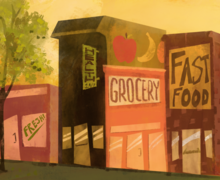Opinion: Unhealthy Marshall Street options worsen food desert for SU students
Flynn Ledoux | Illustration Editor
Students shouldn't have to travel miles off campus for a nutritious meal. Our columnist advocates for more accessible options near SU that promote students’ health goals rather than reliance on fast food.
Get the latest Syracuse news delivered right to your inbox.
Subscribe to our newsletter here.
Syracuse University students are no strangers to Marshall Street. Nestled just off campus, it’s the beating heart of underclassmen life — whether you’re grabbing a cup of coffee, shopping for spontaneous college gear or simply killing time between classes.
Recently, there’s been a noticeable influx of new openings along this strip, sparking both excitement and reflection about how Marshall Street can better serve its student community.
Marshall Street holds untapped potential for catering to the health and lifestyle needs of students. If we take a step back and look at the bigger picture, it’s clear this location still has room to grow, especially in accessible food variety and student food insecurity.
Roughly a third of Syracuse’s population lives below the poverty line, and, as is customary in many low-income American towns, much of the city classifies as a food desert. This issue affects thousands of residents, making it vital to recognize how Marshall Street offerings perpetuate the risks of food deserts for the SU student body.
There’s a real gap in nutritious, convenient and affordable food choices for students, especially in the fast food-heavy landscape that dominates this area of central New York.
When hunger strikes after a long study session or a night out, the options near campus aren’t truly satisfying. Late at night, Popeyes and Chipotle provide limited options that aren’t optimal for students wanting to balance academic stress with a healthy lifestyle.
Even spots that serve salads or acai bowls, luring students in with advertisements of fresh ingredients, often pack them with sugars that quietly further poor nutrition.
The city’s fewer, healthier options are located deeper into the city, limiting accessibility especially late at night and during less crowded hours. Walking long distances or traveling through unfamiliar, sometimes unsafe neighborhoods exposes students to unnecessary danger when seeking better food choices more than two or three miles away.
This makes healthy eating particularly difficult for students without cars, as it’s often not worth the time or motivation to travel for a meal on foot or by rideshare. During winter months, students are even more isolated to the dining halls and Marshall Street options to avoid stacking up transportation costs.
SU students have little choice but to rely heavily on processed foods just to satisfy their hunger.
What Marshall Street needs is options that serve healthier foods with more plant-based, organic ingredients, or meals that are simple but filling without relying on foods that threaten health in the long run.
There’s a real gap in nutritious, convenient and affordable food choices for students, especially in the fast food-heavy landscape that dominates this area of central New York.Autumn Clarke, Columnist
Imagine a 24/7 spot with nutritious wraps, low-sugar smoothies, grain bowls or even meal kits. A place like a fresh grocery outlet could support students throughout the day and night, offering something that helps the body beyond temporarily alleviating cravings.
As more developments come to this student-centric strip, Marshall Street businesses should evolve to include spaces that balance convenience and wellbeing. By offering organic, ready-to-eat meals, Marshall Street would become a cornerstone for health and wellness.
Supporting small, local businesses is a win for both the student body and the economy of Syracuse, providing a sense of pride and ownership in the community while also creating a sanctuary for spontaneous hankerings that don’t involve fast food chains.
Instead of feeling the need to leave campus to find fresh salads, plant-based meals or wholesome ingredients, students deserve to find these choices just a short walk away.
The university and local businesses should be working harder together to prioritize the health of students in our current micro-food desert. If healthy options are available within walking distance, students won’t have to travel far off campus to find the healthy options they need.
Autumn Clarke is a freshman majoring in broadcast and digital journalism. She can be reached at auclarke@syr.edu.
Published on February 9, 2025 at 10:41 pm






